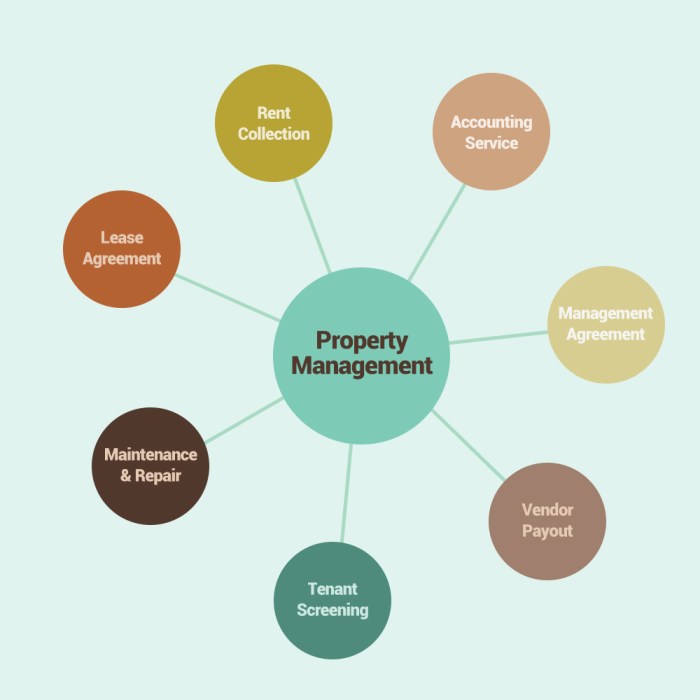Real Estate Portfolio Management: A Comprehensive Guide
Embark on a journey through the realm of real estate portfolio management, where every decision shapes the success of your investments. Explore the intricacies of managing a portfolio that not only thrives but also withstands the test of time.
Delve into the depths of different real estate investment types, diversification strategies, risk management techniques, and performance evaluation methods to craft a well-rounded approach to portfolio management.
Understanding Real Estate Portfolio Management
Real estate portfolio management involves the strategic management of a collection of real estate assets to achieve specific financial goals. This includes acquiring, maintaining, and disposing of properties to maximize returns and minimize risks.
Importance of Managing a Real Estate Portfolio
- Optimizing asset performance to generate maximum returns
- Diversifying investments to spread risk
- Enhancing the overall value of the portfolio
- Aligning the portfolio with the investor's financial objectives
Key Objectives of Real Estate Portfolio Management
- Maximizing returns on investment through effective asset management
- Minimizing risks by diversifying the portfolio
- Enhancing the value of the properties through strategic decision-making
- Aligning the portfolio with the investor's overall financial goals
Challenges Faced in Real Estate Portfolio Management
- Market Volatility: Fluctuations in real estate market values can impact portfolio performance
- Regulatory Changes: Changes in laws and regulations can affect property investments
- Property Management Issues: Maintenance, tenant turnover, and other operational challenges can impact returns
- Capital Constraints: Limited access to capital for acquisitions and improvements can hinder portfolio growth
Types of Real Estate Investments

When it comes to real estate investments for portfolio management, there are various types to consider. Each type offers unique benefits and risks that investors should be aware of in order to make informed decisions.
Residential Real Estate Investments
Residential real estate investments involve properties such as single-family homes, condominiums, and apartment buildings that are used for residential purposes. These types of investments are often seen as relatively stable and can provide a steady income stream through rental payments.
However, they can be affected by factors like economic downturns and changes in housing demand.
- Benefits:
- Steady rental income
- Potential for property appreciation
- Risks:
- Market fluctuations
- Vacancy rates
Commercial Real Estate Investments
Commercial real estate investments involve properties used for business purposes, such as office buildings, retail spaces, and warehouses. These investments can offer higher returns compared to residential properties but may also come with higher risks due to factors like lease negotiations and economic conditions.
- Benefits:
- Potential for higher returns
- Long-term lease agreements
- Risks:
- Economic downturns affecting businesses
- Dependence on tenant stability
Industrial Real Estate Investments
Industrial real estate investments involve properties like warehouses, distribution centers, and manufacturing facilities. These investments can provide stable income from long-term leases with industrial tenants. However, they can also be influenced by factors like changes in supply chain dynamics and technological advancements.
- Benefits:
- Stable rental income
- Increased demand for industrial space
- Risks:
- Technological obsolescence
- Environmental regulations impacting operations
Strategies for Real Estate Portfolio Diversification

When it comes to real estate portfolio management, diversification plays a crucial role in minimizing risk and maximizing returns. Diversification involves spreading investments across different types of real estate assets to reduce exposure to any single asset class or market.
Importance of Real Estate Portfolio Diversification
Diversifying your real estate portfolio is essential to protect against fluctuations in specific markets or sectors. By spreading your investments across various properties, locations, and asset classes, you can lower the overall risk of your portfolio.
Strategies for Diversifying a Real Estate Portfolio
- Investing in Different Types of Properties: Consider investing in a mix of residential, commercial, retail, and industrial properties to diversify your real estate portfolio.
- Geographical Diversification: Spread your investments across different locations to reduce exposure to regional market fluctuations.
- Asset Class Diversification: Explore opportunities in different real estate asset classes such as rental properties, development projects, and real estate investment trusts (REITs).
- Risk Management Strategies: Implement risk management techniques such as hedging, insurance, and contingency planning to protect your investments.
Comparison with Diversification Strategies in Other Asset Classes
While diversification is crucial in all asset classes, real estate offers unique opportunities for diversification compared to stocks or bonds. Real estate investments can provide steady income streams, tax benefits, and potential appreciation, making them a valuable addition to a diversified investment portfolio.
Risk Management in Real Estate Portfolios
Real estate investments come with their own set of risks that investors need to be aware of and manage effectively. By understanding the common risks associated with real estate portfolios and implementing strategies to mitigate these risks, investors can protect their investments and maximize returns.
Common Risks Associated with Real Estate Investments
- Market Risk: Fluctuations in real estate market conditions can impact property values and rental income.
- Liquidity Risk: Real estate investments are not as easily liquidated as stocks or bonds, making it harder to sell properties quickly in times of need.
- Interest Rate Risk: Changes in interest rates can affect mortgage payments and financing costs for real estate investments.
- Location Risk: The location of a property can greatly impact its value and demand, making it susceptible to local economic conditions.
Assessing and Mitigating Risks in a Real Estate Portfolio
- Conduct thorough market research and due diligence before investing in a property.
- Diversify your real estate portfolio by investing in different types of properties across various locations.
- Maintain an adequate cash reserve to cover unexpected expenses or periods of low occupancy.
- Regularly review and adjust your investment strategy based on market conditions and risk assessment.
Role of Leverage in Risk Management in Real Estate
Leverage can amplify returns on real estate investments but also increase risk. By using leverage wisely and managing debt levels effectively, investors can enhance their portfolio's performance while minimizing potential downsides.
Risk Management Strategies Specific to Real Estate Portfolios
- Implement risk management tools such as insurance coverage to protect properties from unforeseen events like natural disasters or accidents.
- Establish strong relationships with property managers and maintenance professionals to ensure properties are well-maintained and tenants are satisfied.
- Stay informed about local market trends and regulations to anticipate changes that may impact your real estate investments.
Performance Measurement and Analysis
In the realm of real estate portfolio management, evaluating performance is crucial for making informed decisions and optimizing returns. Key performance indicators (KPIs) are essential metrics used to assess the success of a real estate portfolio. By analyzing these indicators, investors can gain valuable insights into the financial health and overall effectiveness of their investments.
Key Performance Indicators for Real Estate Portfolio Performance
- Net Operating Income (NOI): This metric measures the profitability of a property by subtracting operating expenses from rental income. A higher NOI indicates better financial performance.
- Capitalization Rate (Cap Rate): The cap rate reveals the rate of return on a property based on its current market value. It helps investors compare different properties and assess their investment potential.
- Total Return: Total return considers both income (rental yield) and capital appreciation to provide a comprehensive view of the overall performance of a real estate portfolio.
Methods for Analyzing Real Estate Portfolio Performance
- Cash Flow Analysis: By examining cash flows including rental income, operating expenses, and debt service payments, investors can evaluate the financial viability of their real estate investments.
- Property Valuation: Regular property valuations help investors understand the current market value of their assets and track changes in property values over time.
- Risk-Adjusted Returns: Adjusting returns for risk factors such as vacancy rates, interest rates, and market volatility enables investors to assess the true performance of their real estate portfolio.
Benchmarking in Real Estate Portfolio Performance
- Comparing performance against benchmarks such as industry averages or market indices provides investors with a standard for measuring the success of their real estate portfolio.
- Benchmarking allows investors to identify areas of strength and weakness in their portfolio, leading to informed decisions for optimizing performance and maximizing returns.
- By benchmarking performance, investors can set realistic goals, track progress, and make adjustments to their investment strategy to achieve desired outcomes.
Conclusive Thoughts

As we conclude this exploration of real estate portfolio management, remember that diligent planning and strategic implementation are the cornerstones of a robust portfolio. Stay informed, stay proactive, and let your portfolio flourish in the dynamic world of real estate investments.
Helpful Answers
What is the role of leverage in risk management in real estate?
Leverage in real estate involves using borrowed capital to increase the potential return of investments. While leverage can amplify profits, it also magnifies risks, especially in volatile markets.
How do you assess and mitigate risks in a real estate portfolio?
Risks in a real estate portfolio can be assessed through thorough property inspections, market analysis, and financial audits. Mitigation strategies include diversification, insurance coverage, and maintaining liquidity.
What are some key performance indicators (KPIs) for evaluating real estate portfolio performance?
Key performance indicators for real estate portfolios include metrics like occupancy rates, rental yields, property appreciation, cash flow, and total return on investment.
Why is benchmarking important in assessing real estate portfolio performance?
Benchmarking allows investors to compare their portfolio performance against industry standards or similar investments. It provides valuable insights into how well a portfolio is performing relative to its peers.